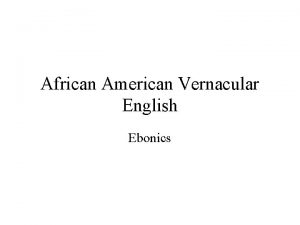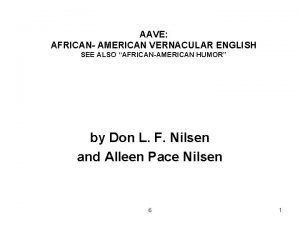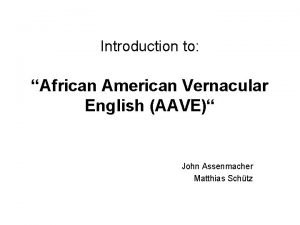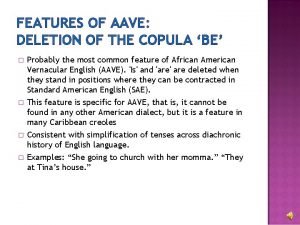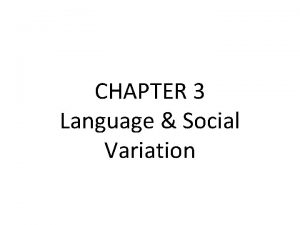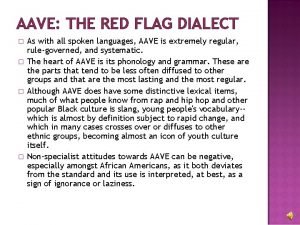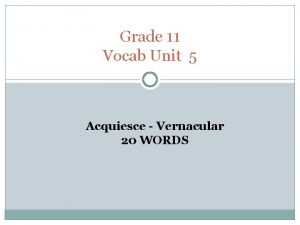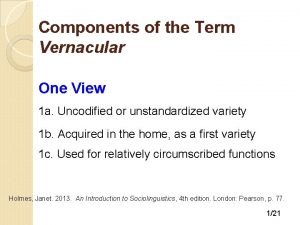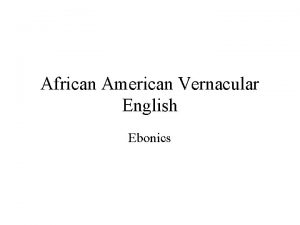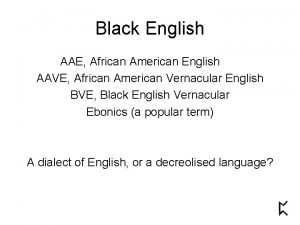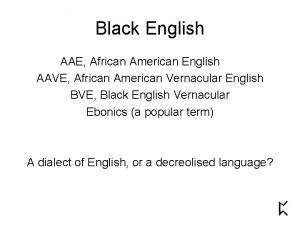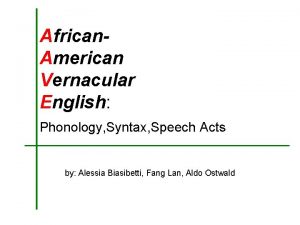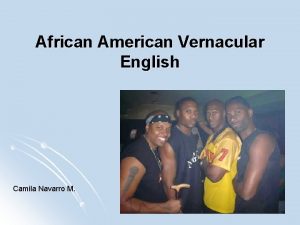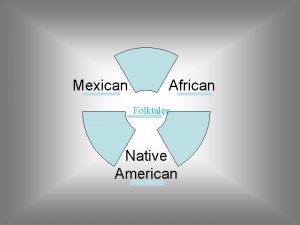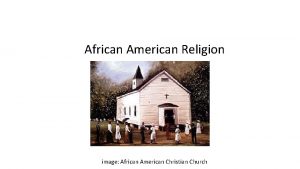Introduction to African American Vernacular English AAVE John






![Phonological Features - reduction of certain diphthongs become monophthongs - [aɪ] to [a] and Phonological Features - reduction of certain diphthongs become monophthongs - [aɪ] to [a] and](https://slidetodoc.com/presentation_image_h/e6e2309040322f796cb8cb8d925de806/image-7.jpg)
![Dental Fricatives - voiceless dental fricative [θ] (thing) -> [t] (ting) - voiced dental Dental Fricatives - voiceless dental fricative [θ] (thing) -> [t] (ting) - voiced dental](https://slidetodoc.com/presentation_image_h/e6e2309040322f796cb8cb8d925de806/image-8.jpg)
![West African-based English creoles and pidgins: - always [d] for "th" regardless of placement West African-based English creoles and pidgins: - always [d] for "th" regardless of placement](https://slidetodoc.com/presentation_image_h/e6e2309040322f796cb8cb8d925de806/image-9.jpg)
![AAVE is non-rhotic - alveolar approximant [ɹ] usually dropped - except: followed by a AAVE is non-rhotic - alveolar approximant [ɹ] usually dropped - except: followed by a](https://slidetodoc.com/presentation_image_h/e6e2309040322f796cb8cb8d925de806/image-10.jpg)
![Final ng [Å‹] - velar nasal [Å‹] ->alveolar nasal [n] - two syllables, e. Final ng [Å‹] - velar nasal [Å‹] ->alveolar nasal [n] - two syllables, e.](https://slidetodoc.com/presentation_image_h/e6e2309040322f796cb8cb8d925de806/image-11.jpg)

![Metathesis - adjacent consonants are switched - particularly when the first is [s] - Metathesis - adjacent consonants are switched - particularly when the first is [s] -](https://slidetodoc.com/presentation_image_h/e6e2309040322f796cb8cb8d925de806/image-13.jpg)






- Slides: 19

Introduction to: “African American Vernacular English (AAVE)“ John Assenmacher Matthias Schütz

History and social context - Roots in trans-Atlantic African slave trade - Captives developed pidgins to communicate

History and social context - Roots in trans-Atlantic African slave trade - Captives developed pidgins to communicate - Over years those pidgins became creoles

Traits of AAVE seperating it from Standard American English - grammatical structures similar to West African languages - changes in pronunciation - distinctive vocabulary - differences in the use of tenses

Phonological and Grammatical Features in AAVE

Phonological Features
![Phonological Features reduction of certain diphthongs become monophthongs aɪ to a and Phonological Features - reduction of certain diphthongs become monophthongs - [aɪ] to [a] and](https://slidetodoc.com/presentation_image_h/e6e2309040322f796cb8cb8d925de806/image-7.jpg)
Phonological Features - reduction of certain diphthongs become monophthongs - [aɪ] to [a] and [ɔɪ] to [oː] - example: "boy" pronounced as [boː]
![Dental Fricatives voiceless dental fricative θ thing t ting voiced dental Dental Fricatives - voiceless dental fricative [θ] (thing) -> [t] (ting) - voiced dental](https://slidetodoc.com/presentation_image_h/e6e2309040322f796cb8cb8d925de806/image-8.jpg)
Dental Fricatives - voiceless dental fricative [θ] (thing) -> [t] (ting) - voiced dental fricative [ð] (then) -> [d] (den) - alveolar stops or labiodental fricatives: [f] and [v] - Examples: smooth [smuːð] -> smoov [smuːv] tooth [tuːθ] is pronounced toof [tuːf]
![West Africanbased English creoles and pidgins always d for th regardless of placement West African-based English creoles and pidgins: - always [d] for "th" regardless of placement](https://slidetodoc.com/presentation_image_h/e6e2309040322f796cb8cb8d925de806/image-9.jpg)
West African-based English creoles and pidgins: - always [d] for "th" regardless of placement - "brudda" for "brother. " AAVE is non-rhotic
![AAVE is nonrhotic alveolar approximant ɹ usually dropped except followed by a AAVE is non-rhotic - alveolar approximant [ɹ] usually dropped - except: followed by a](https://slidetodoc.com/presentation_image_h/e6e2309040322f796cb8cb8d925de806/image-10.jpg)
AAVE is non-rhotic - alveolar approximant [ɹ] usually dropped - except: followed by a vowel, e. g. "strong“ - intervocalic [ɹ] may also be dropped e. g. "story" ->"sto'y" [stÉ”i] - But: rhotic AAVE speakers do exist
![Final ng Å velar nasal Å alveolar nasal n two syllables e Final ng [Å‹] - velar nasal [Å‹] ->alveolar nasal [n] - two syllables, e.](https://slidetodoc.com/presentation_image_h/e6e2309040322f796cb8cb8d925de806/image-11.jpg)
Final ng [Å‹] - velar nasal [Å‹] ->alveolar nasal [n] - two syllables, e. g. "tripping" -> "trippin“ - not in one-syllable content morphemes: sing is sing [sɪŋ] not: sin [sɪn] - But: singing is singin [sɪŋɪn] - Realization of /Å‹/ as [n] feature of many English dialects

Final consonant clusters - reduction of final consonant clusters - test becomes tes, hand becomes han - but pant is unchanged - contains a voiced and a voiceless consonant in the cluster
![Metathesis adjacent consonants are switched particularly when the first is s Metathesis - adjacent consonants are switched - particularly when the first is [s] -](https://slidetodoc.com/presentation_image_h/e6e2309040322f796cb8cb8d925de806/image-13.jpg)
Metathesis - adjacent consonants are switched - particularly when the first is [s] - "ask" is realized as "aks"

Some other features - before nasal consonants /ɛ/ and /ɪ/ both /ɪ/ -> pen and pin (sound the same) - before 'l' /ɪ/ and /i� / both as /ɪ/ -> feel and fill (sound the same) - dropping of /t/ at the end of contractions: don't and ain't -> /doʊn/ and /eɪn/

Grammatical Features

Aspect marking - most distinguishing feature of AAVE is the use of forms of be - used to mark aspect in verb phrases - use or lack of a form of be can indicate whether habitual or not - in SAE: can only be expressed using adverbs, e. g. usually - disputed whether this feature in AAVE has its roots in various West African languages

Examples for Aspect marking - He workin'. - simple progressive - He is working [right now]. - He be workin'. - habitual/continuative aspect - He works frequently or habitually. - He be steady workin'. - intensified continuative - He is working staedily. - He been workin'. - perfect progressive - He has been working.

Negation - negatives are formed differently from SAE - use of ain't as a general negative indicator - used in place of "am not", "isn't", and "aren't" or even "didn't“ - negation agreement: if sentence is negative - all negatable forms are negated as - e. g. I didn't go nowhere. - SE: double negative -> positive (although this wasn't always so)

Literature used: • Mufwene, Salikoko S, 1998. African American English, Structure, history and use. London & New York: Routledge. • Green, Lisa J, 2002. African American English, A linguistic Introduction. Cambridge: Cambridge University Press. • Mufwene, Salikoko S. Africanisms in Afro-American language varieties. Athens: University of Georgia Press. • Schneider, Edgar W, 1989. American earlier Black English. Tuscaloosa: University of Alabama Press.
 African american vernacular english
African american vernacular english Aave english
Aave english African american vernacular english example
African american vernacular english example African american english teacher
African american english teacher Copula deletion example
Copula deletion example Aave examples
Aave examples Vernacular language examples
Vernacular language examples Aave flag
Aave flag Language ties
Language ties Language
Language Vernacular language examples
Vernacular language examples Vernacular variety
Vernacular variety Gkk meaning church
Gkk meaning church Senior anglo vernacular certificate kya hota hai
Senior anglo vernacular certificate kya hota hai Vernacular
Vernacular Different between american english and british english
Different between american english and british english Difference between english and british
Difference between english and british American english vs british english
American english vs british english African american fighter pilots
African american fighter pilots Lesson 5 african american culture and politics
Lesson 5 african american culture and politics
